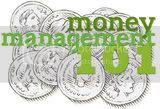
The following is a guest post from Rachel of Porter Coaching.

Note from Tsh: If you hang out with me for an hour, you know I’m a huge Dave Ramsey fan. His plan is the one that led us to become debt-free, and is helping us save tons more than we’ve ever been able to. I get daily emails from readers, worried about their finances and wondering how to live more simply when their financial status forces them to make their decisions. Rachel is a Dave Ramsey certified financial planner, and below, she outlines some of the basic things Ramsey teaches. You might think some of these thing are obvious, but with the current savings rate of Americans below zero, we are not practicing common sense. Yep, we actually have a negative savings rate. Below, Rachel outlines some of those common sense techniques.
1. See where you’re spending.
Start your plan by writing down where you spend every dollar over the next month. You may be surprised at what you’re spending money on – and how much you’re spending on certain things.
Good reads:
- Skimp on the Unimportant So You Can Spend on What Matters
- Seven Powerful Steps That You Can Use to Save $14,341 in the Next Six Months :: Frugal Dad
2. Make a budget.
If you’re married, you both MUST agree to it. Once you know what you’re spending and where, create a written budget and stick to it. It’s the most effective way to stay within your means and curb bad spending habits. Be sure to review your expenses against your budget monthly.
Good reads:
- Zero-Based Budgets for the Home: a Primer
- 10 Things To Do Before Creating Your Next Budget :: No Credit Needed
3. Eliminate your debt – ALL of it.
The more debt you can pay off, the less interest you will have to pay, and the more you can funnel into savings and investments for the future. Start first with getting rid of all your debt except your home mortgage, which you can begin attacking after you’re saving at 12-15% of your gross income, and adequately putting away money for your kids’ college.
Good reads:
- The Emotional Benefits to Becoming Debt-Free
- Get Motivated With a Debt-Elimination Road Map :: Paid Twice
- No Credit Cards – Here’s Why :: Gather Little By Little
4. Start Saving.
A savings plan helps meet financial goals and provides security. Set aside a percentage of your monthly income as savings. Twelve to fifteen percent is a good target if you’re in your 20s or 30s, and increase it if you’re older and behind on your retirement planning. Make it the first “bill” you pay by setting up an automatic investment. Get out of debt first (except your home), though.
Good reads:
5. Pay with cash.
It’s one of the surest ways to stay out of debt and easily control your discretionary spending. Cash categories should at least include groceries, eating out, clothing, personal care, and “blow money” (personal spending). You’ll save more money and get out of debt quicker using the cash system than practically any other method.
Good reads:
- Keep Your Spending Tidy With an Envelope System
- Envelope System Video Tutorial :: No Credit Needed
Which of these do you currently practice in your family? Which of these do you want to implement? Can you add any other tips?
___
Rachel is the founder of Porter Coaching and she is a Dave Ramsey Certified Counselor in the Kansas City area. You can read more of Rachel’s practical insights by visiting her coaching website, Porter Coaching, or check out the Porter Coaching Blog.


